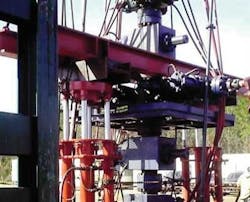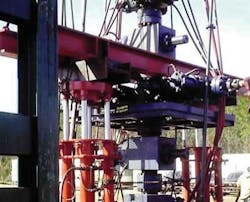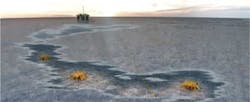New-generation vessels designed for improved motions, faster transit speeds
Jeremy Beckman
Editor, Europe
Installation contractors have invested heavily in recent years to augment their vessel fleets. Although the pace of field development has slowed, the new tonnage will be welcome in areas short of advanced offshore construction capability such as Asia and Australasia.
GustoMSC in Rotterdam has produced designs for two new vessels currently under construction for Seaway Heavy Lifting and China Offshore Engineering Co. (COOEC). The company’s involvement in this sector dates back to the 1960s, when it delivered heavy-duty offshore cranes for barges converted into installation ships.
In the late 1970s, during a boom period for newbuild heavy-lift semisubmersibles, the company designed Heerema’sBalder and Hermod, and the DB101, and the associated offshore cranes. According to Gerrit Schepman, manager Marketing & Business Development, design requirements have not changed greatly since then, as there has been no significant construction of heavy-duty offshore cranes until the last few years. However, some of the early vessels are approaching the end of their life-span.
"In today’s market, the latest offshore cranes provide lifting capability of typically 3,000 to 5,000 tons (2,721-4,536 metric tons) while revolving, but in some cases up to 7,000 tons (6,350 metric tons)," says Schepman. "The newer cranes will also be able to lower their loads below sea level via auxiliary hoists.
"GustoMSC is involved in two directions for heavy-lift vessels. One line is the proprietary designs which we develop and license to yards for construction; the other is EPCI delivery of offshore cranes. We maintain separate teams for each activity, covering design, procurement, sub-contracting of major components, construction management, and project management. These key capabilities are all handled totally in-house. Depending on the size of the project, around 35 staff will be involved during periods of peak activity."
The company also specializes in jackup platforms for installation of lightweight offshore structures and wind turbines using smaller cranes – again proprietary designs, in this case extending to the jacking systems and the dedicated cranes.
"Personally, I believe the present rate of additions to the global construction fleet will ease back," Schepman says. "The major construction opportunities are in Brazil, West Africa, and the Far East, although the position regarding new projects offshore China and their impact on the market remains unclear.
"Off Brazil in particular, the level of heavy-lift activity will depend on the type of production units selected for future projects. If these are predominantly FPSOs or semisubmersibles, which do not need a large offshore crane for offshore hook-up, the requirements will be modest. In West Africa, however, the position could be somewhat different."
For contractors still willing to invest in new tonnage, there are some positive developments, Schepman maintains.
"We see a downward trend in building costs all around the world. The yards are eager to sign, but also the sub-contractors need work. Additionally, the price of steel has come down.
"Our hulls are ship-shaped, and many yards in China and Korea are well suited to assemble these types of units. Aside from our current two contracts, we have various proprietary designs available: some are at the level of a full basic design package (proven by a class society), while others are at a conceptual stage, but based on the proven design.
"Often we have to incorporate the owner’s requirements – generally speaking, to complete a full design package takes around five to six months. But if the shipyard is experienced in offshore construction, it should not need additional assistance to complete the detailed design."
Multi-purpose hull
Down-river from Rotterdam, Merwede Shipyard is close to completing theOlegStrashnov, the second crane vessel in Seaway Heavy Lifting’s fleet. The yard is relatively close to Seaway’s headquarters in Zoetermeer, just outside The Hague.
"For Seaway Heavy Lifting, it makes it much easier to be able to supervise the construction," Schepman says. "This was likely one of the reasons for awarding the contract to a local yard. As with a program in the Far East, you should add a significant amount of money for your supervision team, probably larger than that involved in the Merwede construction."
GustoMSC has a long-standing relationship with Seaway, designing the 2,500-ton (2,268-metric ton) capacity offshore crane of its current flagship vessel theStanislavYudin. For the new vessel, the cooperation was extended to design of an innovative hull shape that would allow the vessel to alternate between heavy lifts and pipelay in S-lay mode, and to attain a fast transit speed of 14 knots, thereby maximizing its availability for projects in far-flung regions.
The initial study phase included formulating and evaluating various new hull concepts, developing the most promising idea to conceptual design level, and performing model tests at the start of the basic design to verify the characteristics of the hull shape for the basic design. GustoMSC also was asked to factor in various other requirements based on Seaway’s operational experiences with theStanislavYudin.
For theOlegStrashnov, a wide hull would be mandatory to provide stability in heavy-lift mode. For pipelay operations, however, a wide hull normally results in unfavorable motion characteristics. A slender hull is more practical in this case, and also more beneficial for improved transit speed.
The solution was a patented, dual-draft type hull. The cross-section of the hull has a relatively narrow width at transit draft, but above the waterline, the width increases substantially. For heavy-lifting tasks, the vessel is ballasted down to a deep draft, at which point the waterline width increases to the maximum width of the vessel, thereby improving stability.
According to an article in GustoMSC’s house magazineInside, this novel arrangement went against prevailing notions concerning vessel stability, structural strength, and loadline issues. But following discussions with classification society DNV, a risk-based design approach was adopted which led to a mutual understanding on the regulatory challenges affecting the hull shape.
GustoMSC then undertook model tests at MARIN’s testing facilities in Wageningen, near Arnhem. The main aims were to assess wave/sponson interaction during the various operating modes; sea-keeping behavior; and verification of the vessel’s design transit speed. Results were satisfactory, and in line with expectations. Previously, the hull shape also had been subjected to a numerical analysis using MARIN’s RAPID software, and subsequent resistance tests had confirmed the calculated transit speed.
The vessel’s layout provides a large, flush working deck between the accommodation area at the forward end, which normally houses a crew of 220, and the revolving offshore crane on the raised poop deck at the aft end, which provides maximum lift capacity of 5,000 tons (4,536 metric tons) at 32 m (105 ft) outreach. Additional lifting is provided by 800-ton (726-metric ton) and 200-ton (181-metric ton) auxiliary hoists and a 110-ton (99.8-metric ton) whip hoist. According to Seaway, this capability will be used for a wide range of activities, from dual-hook upending of large jackets to installation of heavy deck, large subsea structures, TLP/spar foundations, and topsides.
The vessel is 183 m (600 ft) long, 37.8/47 m (124/154 ft) wide (depending on the operating mode), and 18.2 m (59.7 ft) deep, with an operating draft of 13.5 m (44.3 ft) in crane lifting mode and 8.5 m (27.9 ft) for transiting and pipelay. Below deck, a large ballast capacity is provided in tanks on both sides of the vessel between the sideshell and the longitudinal bulkheads. The ballast tanks are arranged so that the tanks in the upper part of the hull serve as the active anti-heeling system during crane operations, facilitating a fast water-ballast transfer at the same level.
Alongside the tanks below the main deck, space has been made available for future installation of a double-jointing S-lay spread accommodated in a tunnel running along the entire centerline of the vessel. Further below deck, areas have been allocated for two ballast pump rooms, two independent main engine rooms, four individual switchboard rooms, two auxiliary machinery engine rooms, and five thruster rooms, with two mooring winch rooms aft. Station keeping is provided either via the DP-3 dynamic positioning system, comprising four azimuthing thrusters (six in pipelay mode) and two tunnel thrusters; or via an eight-point mooring system.
In April 2007, Seaway also contracted GustoMSC for turnkey supply of the heavy-lift crane. The company does not have a role in supervising construction of the vessel.
COOEC cooperation
The other current contract for a newbuild construction vessel is theDPV7500 for COOEC.
"This is a proprietary GustoMSC design," Schepman explains, "which was readily available to be finalized to the owner’s requirements. We have worked together on several projects. Prior to this vessel, we designed a launch barge for COOEC.
COOEC’sDPV7500.
"The ongoing relationship and the availability of theDPV7500 brought us together again on this project…they basically selected our concept and with minor modifications we concluded the design. They are building the vessel presently at their yard in China, and we have subcontracted to them a major part of the offshore crane which we are responsible for under a turnkey contract."
During the 1990s, GustoMSC designed a new type of vessel for ultra deepwater installations. The program included extensive model tests, and was approved by ABS. The conclusion was that the vessel’s motion behavior in medium- and long-term periodic seas compared well with motions of standard semisubmersibles.
DPV7500, a progression of that design, is a combination crane/pipelay, self-propelled vessel capable of laying rigid pipe in DP mode in water depths of up to 2,500 m (8,202 ft). The dynamic positioning system complies with DPS-3 redundancy requirements, making it suitable for deepwater operations in all the mid-Atlantic regions. This vessel will operate primarily in Chinese waters, which generally are mild, according to Schepman.
For transiting, two main, 4.5 MW azimuthing thrusters are fitted at the stern to provide a service speed of 12 knots. Station-keeping is maintained by five retractable, azimuthing fixed-pitch propellers in nozzles, each with output of 3.2 MW. The vessel is 195 m (640 ft) long, 39.2 m (128.6 ft) wide, and with an operational draught of 7-8 m (23-26 ft) for pipelay operations and 8-9 m (26-29 ft) in crane lift mode. A revolving crane at the stern is intended primarily for platform module or jacket lifts weighing up to 4,000 tons (3,629 metric tons) made from a barge. An auxiliary hoist also can be used for smaller subsea lifts.
The pipelay spread can accommodate single- and double-jointing of pipes ranging from 6-60 in. (15-152 cm) in diameter, with storage for up to 9,000 tons (8,164 metric tons) of pipe, a 2 x 200-ton (2 x 181-metric ton) tensioning system, and a 400-ton (363-metric ton) A&R winch, which also can retrieve the pipeline after deployment to the sea bed. A fixed truss stinger aft incorporates a stinger adjustment system.
"We have seen interest from other contractors in theDPV7500," Schepman claims, "although this type of vessel remains a niche market, especially at the top end of crane pipelay vessels for deepwater operations."
GustoMSC also has produced two proprietary design derrick/pipelay barges, theSCB 2000 SJ and SCB 3500 DJ. These are scaled-down, non-self propelled, lower cost vessels intended mainly for pipelay in shallow waters, with supplementary lifting capacity of 2,000–3,500 tons (1,814-3,175 metric tons), depending on client requirements.
"At the moment, we do not have any units targeted specifically at arctic operations, nor have we carried out any installation studies for this purpose. But for this type of activity, I can imagine that the hull and propulsion system will be arctic classed, as was the case with the GustoMSC-designedBully 1 and Bully 2 drillships under construction for Frontier Drilling. In any case, lifting operations will not take place in strong winds, ice splashing, or high waves, which means that crane operations in arctic region installations still will require good weather conditions."


